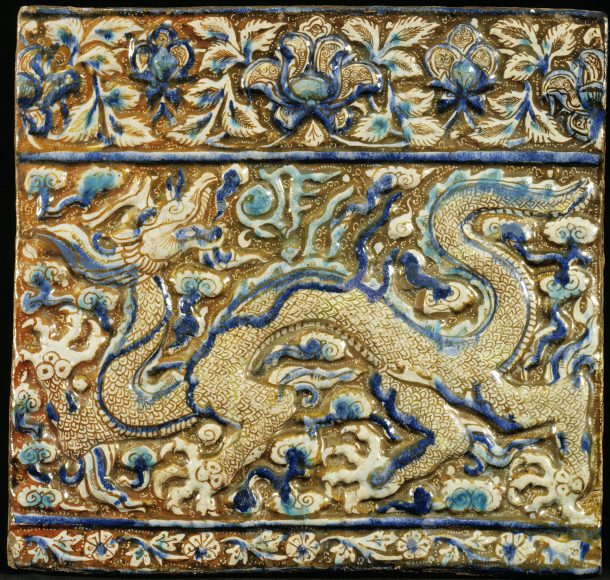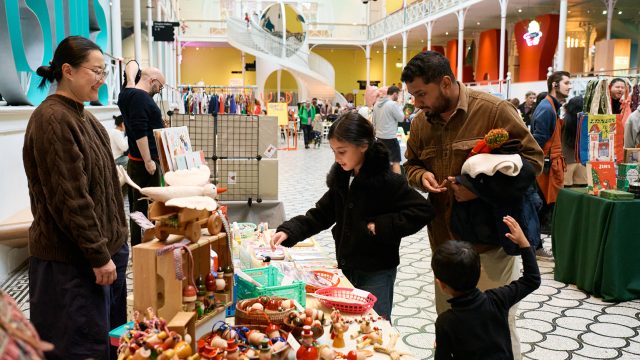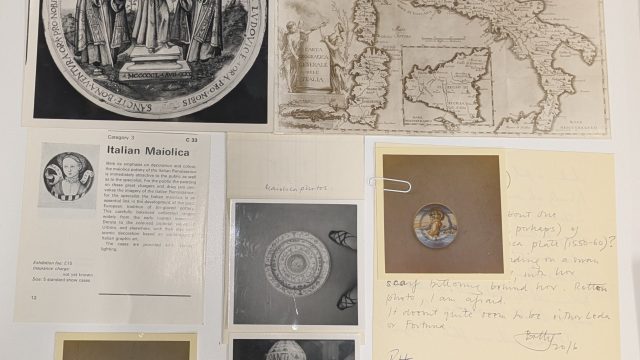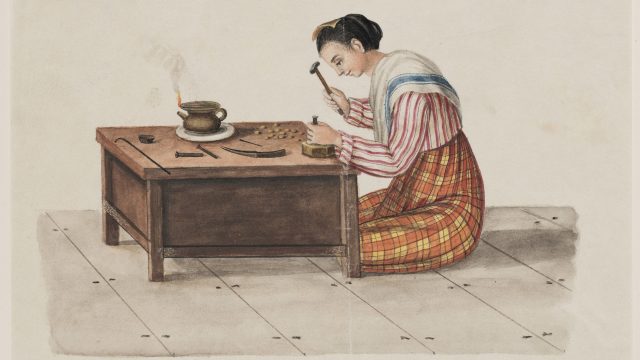Between 19 and 23 July 2021, the V&A Research Institute hosted the online conference Ceramics from Islamic Lands, organised by myself (Curator Middle East, V&A) and Leslee Michelsen (Curator of Collections and Exhibitions at the Shangri La Museum of Islamic Art, Culture & Design in Honolulu). We had been planning a conference on this subject since about 2018, as a way to honour the contribution to this field of Oliver Watson, formerly Keeper of the V&A’s Department of Ceramics and Glass, and a particular authority on lustreware from Iran. The conference title was chosen to evoke the title of Watson’s catalogue of ceramics in the Al-Sabah Collection in the Kuwait National Museum, as well as being as inclusive as possible of the geographical and temporal ranges we wanted to encompass. The confluence of two exhibitions currently showing at the V&A provided the perfect opportunity for holding the conference now: Epic Iran, the UK’s first major exhibition in 90 years to present an overarching narrative spanning 5,000 years of Iranian art, design and culture; and the display Contemporary Ceramic Art from the Middle East, the first show dedicated to exploring the theme of contemporary ceramic art from across this region and its diaspora.

Originally we planned the conference as an in-person event at the V&A in December 2020: we had issued our call for papers, and were starting to receive expressions of interest, but then the Covid-19 pandemic forced us to rethink our plans. Long months of discussion ensued on the possible formats that such a conference might have. We had also received much more interest than we anticipated, with a total of 150 proposals for papers, across a wide range of topics and methodologies, and we wanted to try to accommodate as many of these as possible.
An online format offered a way to do this: we decided to ask our speakers to pre-record their presentations, which our AV team then stitched together into panels; these were uploaded to a closed Vimeo site, which was made accessible to registrants from two weeks before the conference. The conference, as such, was then a week of live panel discussions between the speakers in each session. These took place late morning and mid-afternoon, from Tuesday to Friday across the week – we tried to find times that would enable as many different time zones as possible to join us. The panel discussions were carefully moderated: the speakers gave a very short recap of their papers, the moderator then asked questions to the speakers and directed a discussion between them, before opening out to Q&A from our audience. The week kicked off with a live keynote lecture on the Monday evening.
While it certainly would have been preferable to have met together in person within the walls of V&A, the online format allowed us to bring together a truly international range of speakers and audience members, including several colleagues in countries from which it would have been difficult to travel to London. Our speakers were a truly diverse group, coming from across the UK and Europe, the USA and Canada, Australia, Lebanon, Turkey, Japan, India – and we particularly welcomed the participation of several colleagues in Iran. There were 8 sessions, each featuring 5 speakers and a moderator; together with our keynote speaker, Lisa Golombek, and Oya Pancaroğlu who delivered the closing remarks, we had 60 participants! Their papers discussed themes ranging from significant archaeological finds, ceramic technology and technique, trade across the Mediterranean, the Indian Ocean and the Silk Roads, contacts with Europe, architecture and tilework, collecting history, continuity and change in the 19th century, modernism, and contemporary artistic practice. The regions discussed encompassed the Islamic West, the Middle East, Central Asia, South and South East Asia, Africa and Europe. It was pleasing to include regions that are not often highlighted, and also to give space to the work of a younger generation of scholars.
This event marks the first international conference dedicated to such a range of papers and themes addressing ceramics from Islamic lands. The only other academic meeting on a broad range of ceramics that we have been able to identify was held in Washington DC in 1974, in conjunction with the exhibition Ceramics from the World of Islam, curated by Esin Atıl at the Freer Gallery of Art. Even so, no large scale gathering of scholars in this field has been organised for nearly 50 years. Individual papers or panels are often presented within the context of more general conferences, on art history, archaeology or science, but this conference allowed us to bring together a worldwide community of scholars working in this medium across a diverse range of specialisms and perspectives, to combine approaches, and establish a ‘state of the field’.
It more than delivered on our hopes: it was an extremely rich week of ceramic immersion! It truly was a milestone in the field of ‘Ceramics from Islamic Lands’. The digital format worked better than expected, generating rich and lively discussions, across multiple time zones and international borders. Conversations and information sharing and new collaborations were generated by bringing this group of speakers together, and we hope these conversations will continue and develop. Now it is hoped that we can capitalise on this event to establish a recognised field of study, one that deserves the regular organisation of large and small-scale academic meetings and symposia, and their accompanying publications.
For now, we are happy to share the recordings of the conference’s keynote lecture and live panel discussions, which you can access at the links below. If you would like any further information about the conference, feel free to get in touch with us at vari-events@vam.ac.uk
Opening remarks and keynote lecture
Tristram Hunt, Director of the V&A, welcomed everyone to the conference, introduced its rationale, and set the scene for the range of topics to be covered during the week’s panel discussions. Mariam Rosser-Owen then gave thanks to all the many people who had been involved in making the conference a reality, and Leslee Michelsen said more about our aims for the conference before introducing our keynote speaker, Dr Lisa Golombek (Curator Emerita, Royal Ontario Museum). Dr Golombek’s paper was entitled Recycling the Safavids: the Case of the Garden Panel in the Masjid-i Imam/Shah, Isfahan. This starts at 23:55 in the recording below.
Session 1: The Islamic Mediterranean: Expanding the Canon
This took place on Tuesday 20th July, 12:00 to 13:30 BST. It was moderated by Mariam Rosser-Owen (V&A). The speakers and their paper titles were as follows:
Sonia Gutiérrez Lloret and Victoria Amorós Ruiz (University of Alicante), Changes and Survivals in the Ceramics of early al-Andalus
Elena Salinas and Trinitat Pradell (Universitat Politècnica de Catalunya), Glazed ware in al-Andalus: local innovation and technical transfer
Michael Tite (University of Oxford, in collaboration with Elena Salinas and Trinitat Pradell), Production of Islamic tin oxide and lead antimonate opacified glazed ceramics in Egypt and Tunisia (Ifriqiya) in 10th to 11th centuries
Matteo G. Randazzo (University of Edinburgh), Ceramics from the Emirate of Crete (820s-961 AD) and their connections with contemporary Islamic lands
S. Yona Waksman (Centre National de la recherche scientifique, Lyon), Interactions between the Islamic and the Byzantine worlds: technological issues in pottery manufacture raised by the recent large-scale excavations in Istanbul and Thessaloniki
Session 2: Ceramics of the Medieval Jazira and Beyond
This took place on Tuesday 20th July, 15:30 to 17:00 BST. It was moderated by Marcus Milwright (University of Victoria, BC). The speakers and their paper titles were as follows:
Zohreh Mohammadian Moghayer (Glass and Ceramic Museum of Iran), Continuing Tradition: A Study of Five Incantation Bowls in Glass and Ceramic Museum of Iran
Vanessa Rose (Université Paris 1 – Panthéon-Sorbonne), State of research: reconsidering the corpus of the early tiles from Samarra
Karel Nováček (Palacký University Olomouc) and Jason A. Ur (Harvard University), A Middle Islamic Ceramiscene Landscape in the Hinterland of Arbil (Kurdistan, Iraq)
Stephennie Mulder (University of Texas at Austin), The Ceramics of Balis: Toward the Recovery of Lost Heritage
Micaela Sinibaldi (Shanghai International Studies University and Cardiff University), The Late Petra Project: a new methodology for the analysis of handmade ceramics and for the study of settlement patterns in post-urban Petra
Session 3: From the Caucasus to Central Asia
This took place on Wednesday 21st July, 12:00 to 13:30 BST. It was moderated by Martina Rugiadi (Metropolitan Museum of Art). The speakers and their paper titles were as follows:
Gabriele Puschnigg (Austrian Academy of Sciences) and Jacopo Bruno (University of Turin), Picking up the pieces: tracing change in the early Islamic assemblages of the Bukhara Oasis
Paul Wordsworth (University of Oxford), ‘The most ambitious of all incised wares’. Redefining Aghkand Ware across historical boundaries
Guergana Guionova (Centre National de la recherche scientifique, Aix-Marseille Université) and Thomas Lorain (Mission Archeologique Franco-Afghane de Bâmiyân), Ceramics from Khwajâ Sabz Push Archaeological site, Bâmiyân, Afghanistan
Catherine Klesner (Institute for the Study of the Ancient World, NYU) and Pamela Vandiver (University of Arizona), Reconstructing Production Technology of Islamic Lead-Glazed Ceramics from Central Asian Silk Road Sites
Kate Franklin (Birkbeck, University of London) and Astghik Babajanyan (Armenian National Academy of Sciences), Bridging tradition and innovation: the 12th-15th century ceramic assemblage of the Vayots Dzor Silk Road Survey
Session 4: The Interconnected Indian Ocean
This took place on Wednesday 21st July, 15:30 to 17:00 BST. It was moderated by Nancy Um (Binghamton University). The speakers and their paper titles were as follows:
Anne C Haour (University of East Anglia), Ceramics from the medieval Maldives
Hannah Parsons-Morgan and Nick Tait (University of Exeter), Ceramic Materiality in Islamic Eastern Ethiopia: Consumption and Modification of local and Chinese Ceramics at Mediaeval Harlaa
Stephanie Döpper and Irini Biezeveld (Goethe University, Frankfurt), Surveying Ceramics and Settlements: The Islamic assemblage of Central Oman
Agnieszka Bystron (University of Copenhagen), Changing patterns of ceramic trade in the 18th century Arabian Gulf: the case of Al Zubarah and Freiha, Qatar
Russell Kelty (Art Gallery of South Australia), Made to order: Northern Vietnamese tiles found at Islamic sites in North Java
Session 5: Ceramic production in Iran: lustre to underglaze
This took place on Thursday 22nd July, 12:00 to 13:30 BST. It was moderated by Tomoko Masuya (University of Tokyo). The speakers and their paper titles were as follows:
Abbas Akbari (University of Kashan), Excavation and renovation of a Mongol-period kiln in Kashan: more evidence for Godard’s theory
Fatemeh Alimirzaei (Research Centre for Conservation and Restoration of Cultural Relics, Tehran), Petrographic analysis of lustre potteries from Kashan and Jorjan
Mohamad Reza Ghiasian (University of Kashan), Lustre Ceramic Plaques Produced in Kashan (1478-1560)
Katharina Kuntz (Freie Universität, Berlin) and Fanny Alloteau (Staatliche Museen zu Berlin), The 12th/13th-century CE incised and glazed pottery from Takht-e Soleyman, Iran: insights into dark-coloured clay layers
Yui Kanda (Tokyo University of Foreign Studies), Iranian underglaze-painted ceramic vessels inscribed with Persian verses, c.1450–1700
Session 6: Tiles: Architectural ceramics from Anatolia to the Punjab
This took place on Thursday 22nd July, 15:30 to 17:00 BST. It was moderated by Melanie Gibson (Gingko Library / Trustee Leighton House Museum). The speakers and their paper titles were as follows:
Ana Marija Grbanovic (University of Bamberg), Lost and Found: The Ilkhanid Tiles of the Pir-i Bakran Mausoleum (Linjan, Isfahan)
Bernard O’Kane (American University in Cairo), Before and after the Rukn-i ‘Alam: Early Tilework in the Punjab
Tim Stanley (V&A) and Charlotte Maury (Musée du Louvre), Reconstructing a Lost Treasure of Istanbul: The Tilework of the Çinili Hamam and its Significance
Robert Mason (Royal Ontario Museum), In a Shah’s Garden with You: polychrome tiles from 17th-century Iran
Atefeh Seyed Mousavi (University of Göttingen), Mirzā ʿAbd al-Razzāq Faghfuri: master tile artist in the Qajar Period
Session 7: Ceramics and regional identity in the 19th century
This took place on Friday 23rd July, 12:00 to 13:30 BST. It was moderated by Margaret Graves (University of Indiana, Bloomington). The speakers and their paper titles were as follows:
Hakim Sameer Hamdani (Indian National Trust for Art & Cultural Heritage), Terracotta spires in a 19th-century Sufi shrine of Kashmir: a case of syncretism and regional identity
Fuchsia Hart (University of Oxford), From Stoke-on-Trent to Tehran: English ceramics at the court of Fath-Ali Shah
Moya Carey (Chester Beatty Library), Tilework as Specimens of Arab Art: Stanley Lane-Poole in Cairo 1883
Nolwenn Guedeau (Aix-Marseille Université), Ottoman ‘prestigious’ smoking pipes from the Museum of Boulogne-sur-mer, France
Alexandra Solovyev (University of Oxford), ‘He raised and modernized an art that threatened to be lost’: Joseph-Théodore Deck and Islamic(-style) ceramics
Session 8: Responses to Modernity: the 20th and 21st centuries
The final session took place on Friday 23rd July, 15:30 to 17:30 BST. It was moderated by Venetia Porter (British Museum). The speakers and their paper titles were as follows:
Sato Moughalian (independent scholar), David Ohannessian and the Armenian Ceramics of Jerusalem: The Tiled Niche of the Palestine Archaeological (Rockefeller) Museum (1931 – 34)
Jessica Gerschultz (University of Kansas) , ‘Objects of Imagination’ and its antecedents: revisiting Modernist ceramics in the Arab World
Jillian Echlin (University of York), Iranian Biennial Exhibitions of Contemporary Ceramics 1988 – 2011
Elif Uras (artist), Reinventing Tradition: Iznik pottery and shifting notions of gender and class
Charlotte Bank (independent art historian and curator), Subversive porcelain: social and political commentary in the works of contemporary artists from the Middle East
The conference closed with Oya Pancaroğlu (Boğaziçi University) giving closing remarks. She reflected on the shape of the conference as a whole and on the themes that emerged across its 40 papers; she gave some preliminary remarks on the historiography of the field, and offered thoughts on future steps. She closed by honouring Arthur Lane (1909-63), Curator and then Keeper of Ceramics at the V&A from 1934 to 1963. Lane’s volumes Early Islamic Pottery (1947) and Later Islamic Pottery (1957) remain the only attempt to synthesise a broad understanding of the ceramic output of the central Islamic lands from the 8th to 19th centuries, without being limited by the holdings of a single collection or to the output of a particular region or period. Pleasingly, Dr Pancaroğlu thought Lane would have been keenly appreciative of the spirit and substance of this conference. Closing remarks start at 1:29:50 in the recording below.



Hello Dear
I am Mahboube Ghorbani from Iran. I am studying in archaeology at University of Isfahan. I would like to know about the conferences you may hold for future.
best regards